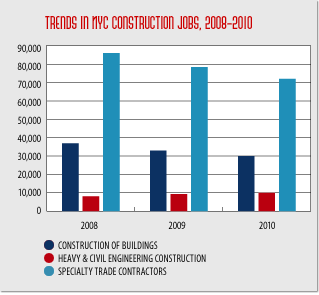
NYC construction spending down 12 percent in 2010; employment off nearly 20,000 from 2008 peak
Overall construction spending in New York City reached $23.7 billion in 2010, a 12 percent decline from 2009, when total spending reached $27.1 billion, according to a New York Building Congress analysis of year-end results. Overall, construction spending is down 23 percent from the peak years of 2007 and 2008 in current dollars.
Construction employment averaged 111,800 in 2010, down from 120,700 in 2009 and 131,400 in 2008. This represents a 15 percent decline in industry jobs over the past two years and the lowest level of construction employment since 2004. An average of 750 jobs was added last year in the heavy construction and engineering sector, which is involved primarily with infrastructure work. Those gains, however, pale in comparison to the loss of 3,000 building construction jobs and 6,500 workers in specialty trades, such as electricians and plumbers.
Government construction spending, which includes investments in mass transit, public schools, roads, bridges and other essential infrastructure, reached $13.5 billion in 2010. While overall spending was down from $15.7 billion in 2009, the public sector still accounted for 57 percent of all New York City construction spending last year. This is the third consecutive year that government spending accounted for more than half of all annual construction expenditures.
Non-residential construction, which includes office space, institutional development, sports/entertainment venues and hotels, declined by 10 percent – from $8.8 billion in 2009 to 8.0 billion in 2010. This sector was spared from further declines due to a number of big-ticket construction projects at the World Trade Center (which accounted for approximately 20 percent of all non-residential construction last year), as well as by arena construction at Atlantic Yards and Madison Square Garden and major office renovations, such as at the Empire State Building and the United Nations.
The residential sector’s steep slump continued and even accelerated slightly in 2010. Spending in this sector declined by 14 percent – from $2.6 billion in 2009 to $2.2 billion in 2010. Similarly, the number of new units created fell from 6,100 in 2009 to 5,400 last year.
For a broader perspective on the residential decline, it is important to compare last year’s results to two years ago. In 2008, New York City produced 34,000 new dwelling units and the $6.73 billion in residential construction spending accounted for 20 percent of all construction spending. In 2010, residential construction accounted for just 9 percent of all spending.
“New York’s construction industry has bent but has not broken as a result of the severe economic downturn that started in 2008,” said New York Building Congress President Richard T. Anderson. “While construction activity and employment remains well below peak levels, a fair amount of work still is underway, especially in the public sector and at the World Trade Center.”
Mr. Anderson continued, “Looking ahead, we should see modest improvements in residential, office and institutional construction in the coming year. The key will be what happens on the government side, which accounts for more than half of all spending. There is concern that lingering budget deficits, along with decreases in federal funding, will result in a severe downsizing of capital programs, especially in City government and at the Metropolitan Transportation Authority.
Charts and Diagrams

Source: U.S. Bureau of the Census, F.W.Dodge*, Capital Budgets of Public Agencies, Urbanomics

Source: New York State Department of Labor
* Dodge data used for this analysis can be purchased at dodge.construction.com



